and the distribution of digital products.
DM Television
Understanding LayerZero: A Comprehensive Overview
- LayerZero is a general-purpose messaging protocol that provides interoperability and standardizes communication across 80+ networks.
- Messages sent over the LayerZero protocol increased 4X over the past two years from over 66,000 in June 2022 to over 1.7 million messages in June 2024.
- LayerZero is used by over 300 user-facing applications and over 54,000 contracts, spanning across gaming, DeFi, cross-chain identity, and enterprise.
- The native token for LayerZero, ZRO, launched in June 2024.
While blockchain networks are designed to be highly secure, they face the challenge of communicating with other networks while maintaining security requirements. This challenge has been exacerbated by the differing security models of various Layer-1s, Layer-2s, and modular networks. The LayerZero protocol was born from the need to securely communicate between networks.
LayerZero allows communication between smart contracts operating on distinct networks. That is, LayerZero enables applications to send messages (i.e., packets of bytes) from a source network that will execute on a destination network.
The core developer of the LayerZero protocol, LayerZero Labs, announced a $6 million Series A round in September 2021, led by Multicoin Capital and Binance Labs. LayerZero V1 launched in March 2022, along with Stargate, a bridge that uses LayerZero to communicate the movement of native assets across networks. In April 2023, LayerZero raised a Series B of $120 million, with backers including a16z crypto and Sequoia Capital.
LayerZero V2 went live in January 2024, aiming to standardize communication across networks with different execution environments. V2 features a common messaging system and modular security properties. By abstracting away complications with communicating between networks, V2 aims to improve developer experience in creating multichain applications.
LayerZero recently launched a native token, ZRO, on June 20, 2024. As of the time of writing, LayerZero has over 54,000 contracts using their network and is live on over 80 different networks, including Ethereum, Solana, Optimism, Arbitrum, Polygon, zkSync, Binance Smart Chain, and Base.
TechnologyLayerZero’s in-network architecture consists of a library of immutable, open-source smart contracts called endpoints. Each network supported by LayerZero has a single endpoint for all incoming and outgoing messages. These endpoints are connected via permissionless infrastructure that specializes in verification and execution.

In V1, the off-network infrastructure consisted of Oracles and Relayers for verifying and executing messages. However, connecting networks with different execution and consensus mechanisms (e.g., Solana and Ethereum) required each connection to adapt its security and communication to the specific execution environments of the connecting networks. This approach posed scalability challenges and limited flexibility for developers.
V2 addressed these challenges by implementing the Omnichain Messaging Protocol (OMP). This version decoupled the verification and execution layers, enhancing modularity and improving censorship resistance. OMP enables LayerZero to facilitate communication between distinct networks with universal semantics and consistent security guarantees for all messages, regardless of their source or destination.
Key RolesIn V2, the Oracles and Relayers have been replaced by Decentralized Verification Networks (DVNs) and permissionless Executors.
DVNsDVNs replace Oracles from V1 and are responsible for verifying that messages are accurate before delivery and executed correctly on the destination chain. DVNs are permissionless and can be run by any external network, organization, or application (e.g., Shrapnel and Tapioca). There are 30+ DVNs currently live, including Google Cloud, Polyhydra’s zklight client, Animoca, and BlockDaemon. Developers can also build adapters for external messaging layers to become DVNs in the network, with Axelar and CCIP being the first.
ExecutorsExecutors replace Relayers from V1 in the protocol. Executors are permissionless, and LayerZero provides open-source tools for builders to iterate upon. Executors are responsible for delivering and executing messages from applications on destination networks. In V2, Executors are separate from the verification layer, which allows for faster speed and less likelihood of bottlenecks. Permissionless execution reduces points of failure and mitigates risks associated with a configured Executor going down.
Messaging Fees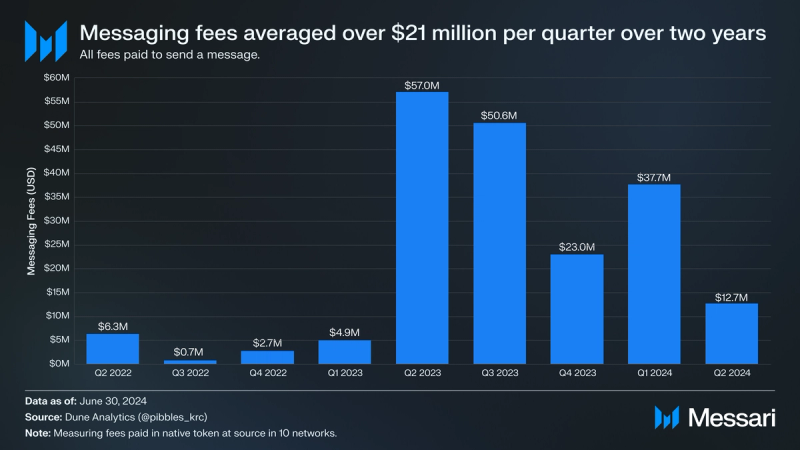
DVNs and Executors are incentivized by a portion of the fees paid by users sending a message (sender). A send transaction is triggered when a sender begins the process of a message transfer. This transaction shows up as an event on the source network, and then the user pays a fee in the native token of the source network. This fee serves three purposes:
- To distribute to DVNs and Executors
- To pay for gas on the destination chain
- To burn on the source chain if protocol fee accrual is active
These logs exist on all endpoint contracts and are stored on the network where the message was sent from.
ZRO holders have control over the protocol accrual fees and can vote every six months to activate or deactivate this fee via a referendum. This process is enforced by immutable smart contracts and allows ZRO holders to modulate messaging fees.
Fees paid for messaging on LayerZero protocol averaged over $21 million per quarter over the past two years, peaking at $57 million in Q2 2023. Despite a recent drop due to reduced gas fees from the Dencun upgrade in the Ethereum ecosystem and decreased Sybil farming, Q2 2024 still saw $12.7 million collected — double the amount from two years ago.
SecurityWith over $1.7 billion exploited due to cross-network vulnerabilities in 2023 alone, security is top of mind for developers building multi-network applications. LayerZero addresses this problem via intrinsic security. The approach focuses on the security guarantees of the transport layer and not the security requirements of individual networks that are connected to LayerZero (extrinsic to the transport layer). This allows for fewer security assumptions when sending messages. It also improves scalability and the developer experience, as developers no longer worry about variable security models between networks. The criteria for LayerZero’s intrinsic security are: lossless (e.g., censorship resistance), exactly-once (e.g., no duplicate messages), and guaranteed delivery.
LayerZero protocol allows applications to customize their own security stack, consisting of DVNs, Executor(s), network conformations, MessageLibraries, and pathways for omnichain messaging. Applications can choose which DVNs and how many verify their messages. For example, messages transferring high-value tokens or messages may opt for more DVNs (higher security), than other messages, such as low-value NFT transactions or a state sync call. This flexibility allows applications to control their security and customize their fee structures based on the value of the assets being transferred.
All core LayerZero contracts are append-only, allowing applications to opt into upgrades at their discretion. The implementation of V2 is both forward-compatible and backward-compatible with V1 architecture.
Universal SemanticsUniversal semantics provides standardized endpoints and communications between networks, eliminating the need for network-specific adaptations. As such,applications can add new networks without requiring developers to learn unique communication pathways between networks. Also, developers can more easily coordinate contracts across multiple networks creating unified applications (e.g., tokens, lending markets, governance, domain names, etc.).
Message design patterns provide developers with the flexibility and control to build complex omnichain applications (OApps). Beyond simple one-way transfers, OApps can send messages to multiple networks using standardized communication, enable two-way communication with the source network, and allow applications on destination networks to trigger events on other applications. This versatility empowers developers to create sophisticated and interconnected OApps that leverage the full potential of LayerZero’s omnichain capabilities.
Omnichain Application (OApp) StandardCoordination between contracts on different networks is challenging due to differing contract standards. The omnichain application contract standard offers a universal, blockchain-agnostic developer interface, allowing developers to build an application once and deploy it across multiple chains without rewriting code. Doing so reduces development time and opens up more networks to their applications, accessing the users and liquidity of any LayerZero-supported blockchain.
LayerZero protocol can integrate and coordinate multiple applications, allowing for complex cross-chain applications in decentralized finance (DeFi), governance, identity, asset management, and revenue/reward distribution. LayerZero supports over 300 user-facing applications and over 54,000 OApps.
Omnichain Fungible Token (OFT) StandardToken standards differ between networks. Omnichain Fungible Token (OFT) is a token standard developed by LayerZero to unify token standards across different networks, thus enabling seamless cross-chain liquidity. There are two distinct approaches to issuing OFTs:
- Lock and mint (OFT adaptor) – employed for tokens already minted in a native network.
- Burn and mint (OFT transfers) – used for tokens that are minted specifically for LayerZero protocol.
In addition, Omnichain Non-Fungible Tokens can also be issued on LayerZero, inheriting similar properties to OFTs. Since endpoints are append-only and upgrades are optional, OFT deployers have full control over the contract. In the case of OFT transfers, the token supply between networks remains consistent since tokens are natively burned and minted in source and destination networks, respectively.
Over 120 projects employ the OFT Standard, including Ethena (ENA, USDe, and sUSDe), EtherFi (weETH), PancakeSwap (CAKE), and LayerZero (ZRO).
PrecrimePrecrime is a security feature from LayerZero Labs that allows a relayer to stop a hack before it happens. It leverages predictive algorithms by forking a destination blockchain before the delivery of a message and running the transaction locally. After running the transaction, Precrime checks the state of the blockchain and verifies no malicious action occurred. By preemptively detecting and preventing fraudulent transactions, Precrime provides an added layer of security for messaging and safeguards asset transfers.
Token Launch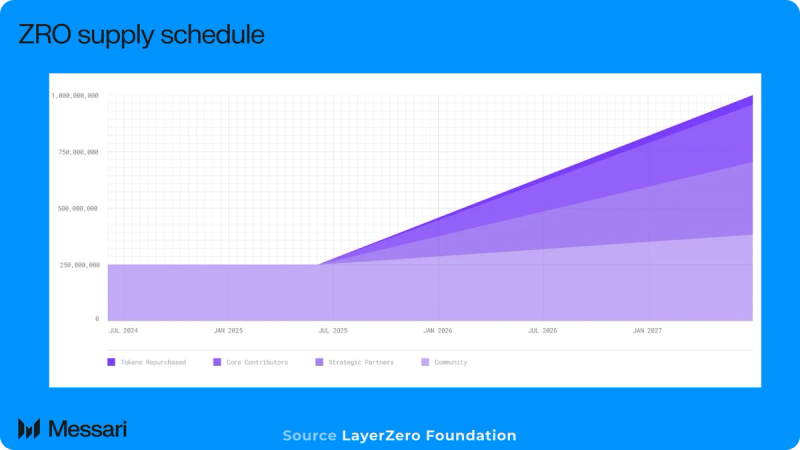
LayerZero's token, ZRO, launched on June 20, 2024, with a total supply of 1 billion. The protocol is allocating 23.8% of its total supply directly to the community and builders, excluding foundation and growth allocations – which have a separate 14.5% allocation. On the first day, 8.5% of the supply was distributed: 5% to core contributors, 3% via Request for Proposals (RFP), and 0.5% to a community pool. The remaining tokens are set to be distributed over the next 36 months, with additional retroactive distributions every 12 months and further RFPs for future builders. The breakdown of the distribution is as follows:
- 38.3% to LayerZero Community (383 million ZRO)
- 32.2% to Strategic Partners (322 million ZRO)
- 25.5% to Core Contributors (255 million ZRO)
- 4.0% Tokens Repurchased (40 million ZRO)
To incentivize development on LayerZero, RFPs were conducted before the token launch in May 2024. Developers had to launch an OApp on the LayerZero protocol to be considered for allocation. Over 200 developer teams submitted applications for ZRO allocations and deployed their own OApp.
Since LayerZero's launch in 2022, nearly 6 million unique wallet addresses have interacted with the protocol. To ensure fair token distribution in 2024, LayerZero implemented a three-step process to exclude Sybil users, i.e., those using multiple addresses (20+ wallet clusters) to game the system. Sybil activities include industrial farming, moving valueless NFTs, and using specific Sybil farming apps. Sybil users were given a chance to self-report and receive 15% of their intended allocation. Those who failed to report are publicly listed and could be reported by others for a bounty.
To distribute ZRO, LayerZero used a novel mechanism known as Proof of Donation. This method allowed participants to claim ZRO tokens by donating to Protocol Guild, a funding mechanism for Ethereum’s Layer-1 research and development. The donation was $0.10 in USD stablecoin or ETH. LayerZero Foundation matched all donations up to $10 million for Protocol Guild.
The ZRO token allows holders to control protocol fee switch through governance. Every six months, ZRO holders can vote on activating or deactivating the protocol’s fee switch via an immutable onchain (and omnichain) vote. If activated, fees collected are used to burn ZRO by the Treasury Contract. This mechanism ensures that ZRO holders have direct influence over the protocol’s fee structure. All governance is managed onchain via immutable contracts. The LayerZero Foundation was established to support the community of ZRO holders.
Ecosystem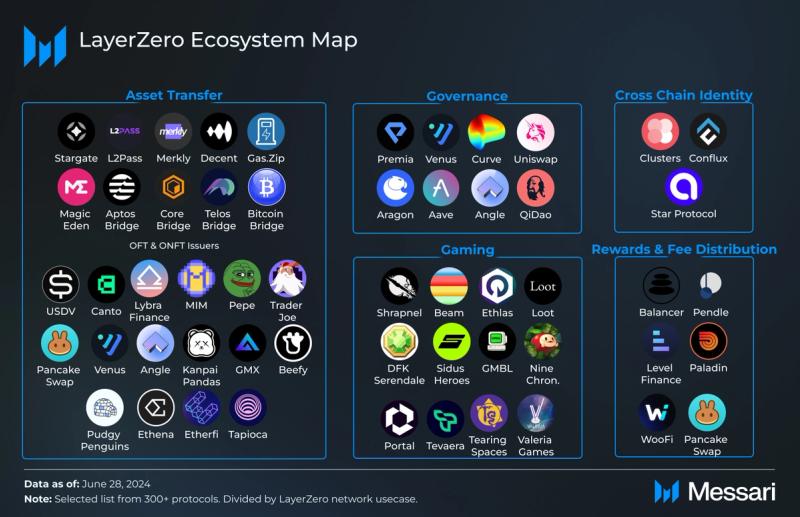
Currently, the LayerZero network has over 300 user-facing applications built on it across 80 chains, which includes 120 OFTs and 54,000 deployed OApp contracts. These OApps use LayerZero messaging for a host of use cases. The most common and high value is securely transferring assets from one network to another. This can be done via bridges or via protocols issuing OFTs and ONFTs.
Other use cases include cross-chain identity, voting across networks, distribution of rewards/revenue on different networks, and gaming. Users of LayerZero include:
- Angle for a collateral-backed stablecoin OFT and cross-chain voting.
- ether.fi for L2 native restaking for weETH.
- Gas.zip allows users to refuel gas across LayerZero networks.
- PancakeSwap’s native token, Cake, is an OFT used to incentivize liquidity.
- Ethena issues an OFT synthetic stablecoin, USDe.
- Clusters can aggregate multiple wallets on different networks under a single name ID.
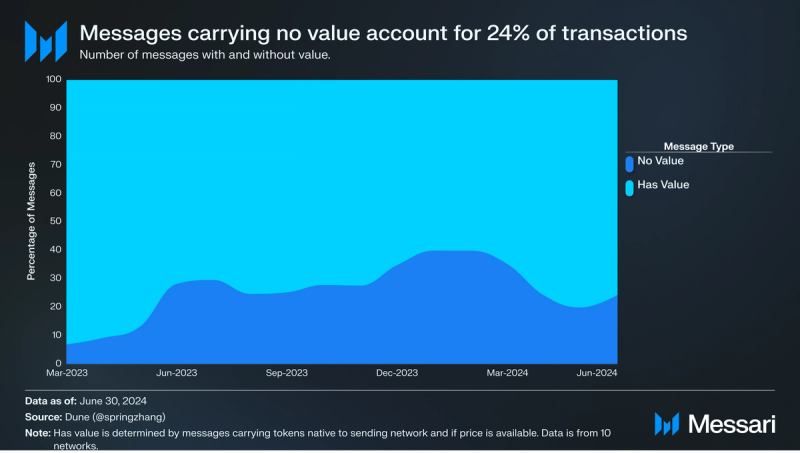
A number of use cases (e.g., voting, identity, ONFTs, and gaming) do not yet have an explicit value; however, they are critical to the function of protocols. Messages without a known value have seen significant growth since March 2023, going from less than 10% of daily sent messages to 24% in June 2024 on the 10 networks measured. This growth demonstrates that developers are using LayerZero to build complex OApps that cater to a wide range of multi-network use cases, moving beyond simple asset transfers. Currently, measuring asset transfer volumes is limited, because values of certain assets are not readily available.
EnterpriseEnterprises, especially in financial services, are leveraging LayerZero for blockchain interoperability. Notably, J.P. Morgan and Apollo's Onyx Digital Assets, under the Monetary Authority of Singapore’s Project Guardian, utilize LayerZero for seamless integration with private blockchains. Additionally, LayerZero enables interoperability with Avalanche’s Evergreen Subnet, Spruce. Google Cloud operates a Decentralized Validator Network (DVN) for LayerZero, paving the way for future enterprise infrastructure providers and giving OApps an enterprise-grade signer to use if they so desire.
LayerZero Labs collaborated with IntellectEU to support the first Delivery vs. Payment (DvP) transaction using the LayerZero protocol to send Swift MT messages between Hyperledger Besu (private) and Polygon (public) blockchains. DvP transactions are being developed to enable existing financial institution infrastructure to seamlessly communicate with blockchains. This adoption and development underscore LayerZero's pivotal role in enabling secure and efficient cross-chain communication for enterprise applications.
UsageMessage VolumeMessages sent over the LayerZero network increased 4X on a monthly basis over the past two years from 66,000 in June 2022 to over 1.7 million messages in June 2024, according to LayerZero Scan. As of June 2024, the largest source for messages came from Arbitrum (>570,000), Base (>275,000), Optimism (>246,000), and BNB Smart Chain (>127,000), which are all networks with low transaction fees and high TVL.
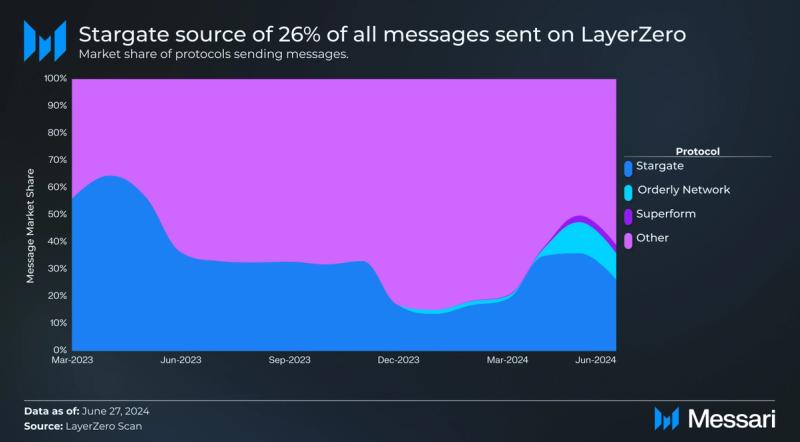
Stargate, the first bridge launched on LayeZero, secured over $390 million in assets on August 7, 2024, peaking at over $4 billion in TVL in April 2022. It also has the highest volume of any bridge in the market (7 day volume: $232 million). While having robust transfer volume, the market share of Stargate messages sent over LayerZero has gone from 64% (6.x million messages) at its peak in April 2023 to 26% (456,000 messages) in June 2024. This is due to a growing number of protocols adopting LayerZero for asset transfers, such as Orderly, Etherfi, Superform, LayerZero (OFT), Merkly, and L2 pass. For example, Orderly Network and Superform have gained market share of messages going from 0% in June 2023 to 10% (Orderly Network; 169,000 messages) and 3% (Superform; 53,000 messages), respectively. The shift in Stargate's dominance highlights the diversity of applications contributing to LayerZero’s messaging market share and demonstrates how new protocols can quickly capture significant portions of the market. Currently, it is difficult to correlate asset transfer volumes to message volumes, because the values of certain assets are not readily available.
Transfer Volume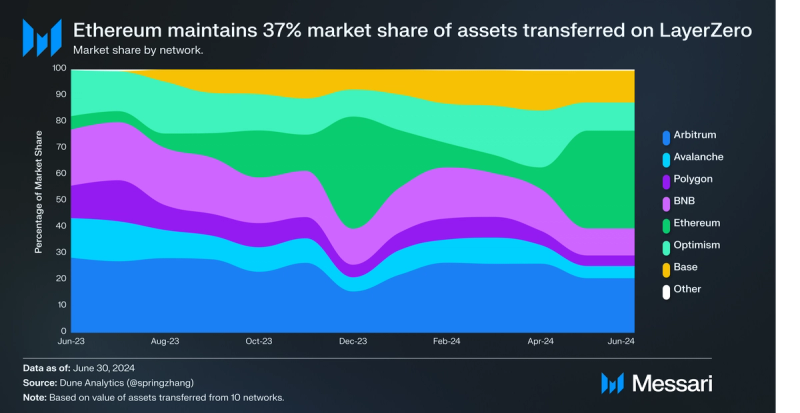
Asset transfer volume on bridges using LayerZero averaged $2.4 billion per month from June 2023 to June 2024. In June 2024, Ethereum led asset transfers with a 37% market share ($323 million), followed by Arbitrum at 21% ($180 million) and Optimism at 11% ($93 million). This data represents a number of protocols transferring assets including: Stargate and EtherFi. These figures are based on available prices and native tokens, suggesting the actual value may be higher.
RoadmapV2 continues to be the “most significant iteration” the protocol has undergone. Below are three of the most relevant components from the upgrade.
Community Building DVNsBeyond improving protocol security, DVNs unlock a new way for many different organizations, groups, and individuals previously not involved in V1 to become active contributors to the protocol. Even third-party bridges can participate as DVN providers and earn fees from LayerZero’s network. For example, adaptors have been developed to integrate Axelar and Chainlink’s CCIP.
Organizations Building ExecutorsWith new OApps being developed, developers and organizations may opt to implement their own Executor. By having their own executor, developers and organizations increase their participation in key infrastructure that is securing their OApp, as well as adding a potential revenue stream.
Non-EVM ExpansionIn May 2024, LayerZero Network integrated Solana and TRON, expanding the non-Ethereum Virtual Machine (EVM) networks supported. Solana's integration initially supported eight networks, with plans to expand to all 80+ networks LayerZero supports. Additionally, LayerZero has partnered with Initia Labs to explore expanding omnichain support to Cosmos chains. These expansions demonstrate LayerZero's commitment to standardize interoperability across diverse blockchain ecosystems.
Closing SummaryLayerZero is a messaging protocol that aims to standardize multi-network communication and development. The launch of LayerZero V2 improves the developer experience and allows the network to scale more easily. The launch of the token, ZRO, brings new incentive opportunities to the growing ecosystem. With its focus on decentralization and security, LayerZero has secured its place as a significant player in the emerging multi-network messaging space.
- Home
- About Us
- Write For Us / Submit Content
- Advertising And Affiliates
- Feeds And Syndication
- Contact Us
- Login
- Privacy
All Rights Reserved. Copyright , Central Coast Communications, Inc.